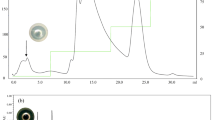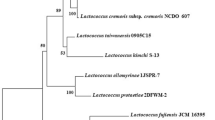Abstract
Emergence of food borne pathogens and multidrug resistant organisms has enforced the screening of natural antimicrobial compounds. Bacteriocins are ribosomally synthesized natural antimicrobial peptides produced by numerous bacteria. These antimicrobial peptides are gaining more attention as alternative therapeutics in pharmaceutical industry as next-generation antibiotics targeting the multi-drug resistant pathogens and as a bio preservative in food industry. The current study is aimed to purify and characterize a broad spectrum bacteriocin (Bac-IB45) with the determination of its plausible mode/mechanism of action. In this research, Bac-IB45 from Lactobacillus plantarum KIBGE-IB45 was 41.71-fold purified with the molecular mass of 20.5 kDa estimated using tricine SDS-PAGE. This bacteriocin is highly thermostable and pH stable in nature. It also exhibited stability against various metal ions, surfactants and organic solvents. Purified Bac-IB45 showed broad antimicrobial potential against various multidrug resistant, food borne bacterial and fungal pathogens. However, Bac-IB45 was found to be sensitive to various proteolytic enzymes. The time-kill assay of Bac-IB45 and scanning electron microscopic analysis revealed the bactericidal mode/mechanism of action against Listeria monocytogenes ATCC 7644. This unique Bac-IB45 with broad spectrum of inhibition and bactericidal mode of action could be used as a natural food preservative and as alternative therapeutics to solve the unrestrained problems of industries.







Similar content being viewed by others
References
Adebayo CO, Aderiye BI (2010) Antifungal activity of bacteriocins of lactic acid bacteria from Nigerian fermented foods. Res J Microbiol 5:1070–1082
Alam SI, Kamran M, Sohail M, Ahmad A, Khan SA (2011) Partial characterization of bacteriocin like inhibitory substance from Bacillus subtilis BS15, a local soil isolate. Pak J of Bot 43:2195–2199
Amrita RM, Kadirvelu J (2019) Inhibiting bacterial colonization on catheters: antibacterial and antibiofilm activities of bacteriocins from Lactobacillus plantarum SJ33. J Glob Antimicrob Resist 19:85–92
Ansari A, Siddiqui NN, Ghani M, Aman A, Qader SAU (2015) Plasmid borne BAC-IB17: localization of a potential antibacterial positive marker (Bac+) encoded broad inhibitory spectrum bacteriocin. Pak J of Pharm Sci 28:1331–1335
Ansari A, Zohra RR, Tarar OM, Qader SAU, Aman A (2018) Screening, purification and characterization of thermostable, protease resistant bacteriocin active against methicillin resistant Staphylococcus aureus (MRSA). BMC Microbiol 18:1–10
Avaiyarasi ND, Ravindran AD, Venkatesh P, Arul V (2016) In vitro selection, characterization and cytotoxic effect of bacteriocin of Lactobacillus sakei GM3 isolated from goat milk. Food Control 69:124–133
Bajpai VK, Sharma A, Baek KH (2013) Antibacterial mode of action of Cudrania tricuspidata fruit essential oil, affecting membrane permeability and surface characteristics of food-borne pathogens. Food Control 32:582–590
Blasi B, Peca L, Vass I, Kós PB (2012) Characterization of stress responses of heavy metal and metalloid inducible promoters in synechocystis PCC6803. J Microbiol Biotechnol 22:166–169
Campion A, Casey PG, Field D, Cotter PD, Hill C, Ross RP (2013) In vivo activity of nisin A and nisin V against Listeria monocytogenes in mice. BMC Microbiol 13:1–8
Castellano P, Belfiore C, Fadda S, Vignolo G (2008) A review of bacteriocinogenic lactic acid bacteria used as bioprotective cultures in fresh meat produced in Argentina. Meat Sci 79:483–499
Cotter PD, Ross RP, Hill C (2013) Bacteriocins: a viable alternative to antibiotics? Nat Rev Microbiol 11:95–105
Devi AN, David RA, Venkatesh P, Arul V (2016) In vitro selection, characterization and cytotoxic effect of bacteriocin of Lactobacillus sakei GM3 isolated from goat milk. Food Control 69:124–133
Elayaraja S, Annamalai N, Mayavu P, Balasubramanian T (2014) Production, purification and characterization of bacteriocin from Lactobacillus murimus AU06 and its broad antibacterial spectrum. Asian Pac J Trop Biomed 4:S305–S311
Elotmani F, Juneells AMR, Assobhei O, Milliere JB (2002) Characterization of anti-Listeria monocytogenes bacteriocins from Enterococcus faecalis, Enterococcus faecium, and Lactococcus lactis strains isolated from Raïb, a Moroccan traditional fermented milk. Curr Microbiol 40:10–17
Gálvez A, Valdivia E, Martínez-Bueno M, Maqueda M (1990) Induction of autolysis in Enterococcus faecalis S-47 by peptide AS-48. J Appl Bacteriol 69:406–413
Gao Y, Jia S, Gao Q, Tan Z (2010) A novel bacteriocin with a broad inhibitory spectrum produced by Lactobacillus sake C2, isolated from traditional Chinese fermented cabbage. Food Control 21:76–81
Ge J, Ping W, Song G, Du C, Ling H, Sun X, Gao Y (2009) Paracin 1.7, a bacteriocin produced by Lactobacillus paracasei HD1.7 isolated from Chinese cabbage sauerkraut, a traditional Chinese fermented vegetable food. Wei Sheng Wu Xue Bao 49:609–619
Ghadbane M, Harzallah D, Laribi AL, Jaouadi B, Belhadj H (2013) Purification and biochemical characterization of a highly thermostable bacteriocin isolated from Brevibacillus brevis strain GM100. Biosci Biotechnol Biochem 77:151–166
Giuliani A, Pirri G, Nicoletto S (2007) Antimicrobial peptides: an overview of a promising class of therapeutics. Open Life Sci 2:1–33
Goh HF, Phillip K (2015) Purification and characterization of bacteriocin produced by Weissella confusa A3 of dairy origin. PLoS ONE 10:1–17
Hammami I, Jaouadi B, Bacha AB, Rebai A, Bejar S, Nesme X, Rhouma A (2012) Bacillus subtilis bacteriocin bac 14B with a broad inhibitory spectrum: purification, amino acid sequence analysis, and physicochemical characterization. Biotechnol Bioprocess Eng 17:41–49
Ibrahim F, Aman A, Siddiqui NN, Zohra RR, Qader SAU, Ansari A (2019) Screening of antilisterial efficacy and partial purification of chromosomally located bacteriocin isolated from lactobacillus plantarum. Int J Biol Biotechnol 16:283–290
Jeevaratnam K, Jamuna M, Bawa AS (2005) Biological preservation of foods-bacteriocins of lactic acid bacteria. Ind J Biotechnol 4:446–454
Kamoun F, Mejdoub H, Aouissaoui H, Reinbolt J, Hammami A, Jaoua S (2005) Purification, amino acid sequence and characterization of Bacthuricin F4, a new bacteriocin produced by Bacillus thuringiensis. J Appl Microbiol 98:881–888
Kamoun F, Fguira IB, Hassen NB, Mejdoub H, Lereclus D, Jaoua S (2011) Purification and characterization of a new Bacillus thuringiensis bacteriocin active against Listeria monocytogenes, Bacillus cereus and Agrobacterium tumefaciens. Appl Biochem Biotechnol 165:300–314
Kang HK, Kim C, Seo CH, Park Y (2017) The therapeutic applications of antimicrobial peptides (AMPs): a patent review. J Microbiol 55:1–2
Khalil R, Elbahloul Y, Djadouni F, Omar S (2009) Isolation and partial characterization of a bacteriocin produced by a newly isolated Bacillus megaterium 19 strain. Pak J Nutr 8:242–250
Kormin S, Rusul G, Radu S, Ling FH (2001) Bacteriocin-producing lactic acid bacteria isolated from traditional fermented food. Malays J Med Sci 8:63–68
Kumar S, Tsai CJ, Nussinov R (2000) Factors enhancing protein thermostability. Protein Eng 13:179–191
Liu G, Song Z, Yang X, Gao Y, Wang C, Sun B (2016) Antibacterial mechanism of bifidocin A, a novel broad-spectrum bacteriocin produced by Bifidobacterium animalis BB04. Food Control 62:309–316
Lowry OH, Roserough NJ, Farr AL, Randall RJ (1951) Protein measurement with the Folin phenol reagent. J Biol Chem 193:265–275
Lv X, Miao L, Ma H, Fengling B, Yang L, Mengtong S, Jianrong L (2018) Purification, characterization and action mechanism of plantaricin JY22, a novel bacteriocin against Bacillus cereus produced by Lactobacillus plantarum JY22 from golden carp intestine. Food Sci Biotechnol 27:695–703
Malheiros PDS, Daroit DJ, Brandelli A (2012) Inhibition of Listeria monocytogenes in minas frescal cheese by free and nanovesicle-encapsulated nisin. Braz J Microbiol 43:1414–1418
Malini M, Janakirama S (2012) Detection of heat stable bacteriocin from Lactobacillus acidophilus NCIM5426 by liquid chromatography/mass spectrometry. Ind J Sci Technol 5:2325–2332
Martinez RCR, Alvarenga VO, Thomazini M, Fávaro-Trindade CS, de Souza SA (2016) Assessment of the inhibitory effect of free and encapsulated commercial nisin (Nisaplin®), tested alone and in combination, on Listeria monocytogenes and Bacillus cereus in refrigerated milk. LWT Food Sci Technol 68:67–75
Maurya AP, Thakur RL (2012) Inhibition spectrum, purification and characterization of bacteriocin from Leuconostoc NT-1. Curr Sci 103:1405–1407
Odah KA, Dong WL, Lei L, Atiah LA, Wang YM, Kong LC, Ma HX (2019) Isolation, identifcation, and characterization of a novel bacteriocin produced by Brevibacillus laterosporus DS–3 against methicillin–resistant Staphylococcus aureus (MRSA). Int J Pept Res Ther. https://doi.org/10.1007/s10989-019-09878-4
Ogino H, Uchilo T, Yokoo J, Kobayashi R, Ichise R, Ishikawa H (2001) Role of intermolecular disulfide bonds of the organic solvent-stable PST-01 protease in its organic solvent stability. Appl and Environ Microbiol 67:942–947
Ogunbanwo ST, Sanni AI, Onilude AA (2003) Characterization of bacteriocin produced by Lactobacillus plantarum F1 and Lactobacillus brevis OG1. Afr J Biotechnol 2:219–227
Ohenhen RE, Isibor JO, Emonfonmwan G, Enabulele SA (2015) Effects of PH and storage temperatures on antibacterial activity of bacteriocin produced by lactic acid bacteria isolated from OGI. Br Microbiol Res J 9:1–9
Oman TJ, Boettcher JM, Wang H, Okalibe XN, van der Donk WA (2011) Sublancin is not a lantibiotic but an S-linked glycopeptide. Nat Chem Biol 7:78–80
Parapouli M, Delbes-Paus C, Kakouri A, Koukkou AI, Montel MC, Samelis J (2013) Characterization of a wild, novel nisin a-producing Lactococcus strain with an L. lactis subsp. cremoris genotype and an L. lactis subsp. lactis phenotype, isolated from Greek raw milk. Appl Environ Microbiol 79:3476–3484
Schägger H (2006) Tricine–SDS-PAGE. Nat Protoc 1:16–22
Sharma N, Kapoor R, Gautam N, Kumari R (2011) Purification and characterization of bacteriocin produced by Bacillus subtilis R75 isolated from fermented chunks of mung bean (Phaseolus radiatus). Food Technol Biotechnol 49:169–176
Sharma G, Raturi K, Dang S, Gupta S, Gabrani R (2017) Inhibitory effect of cinnamaldehyde alone and in combi-nation with thymol, eugenol and thymoqui-none against Staphylococcus epidermidis. J Herb Med 9:68–73
Simova ED, Beshkova DB, Dimitrov ZP (2009) Characterization and antimicrobial spectrum of bacteriocins produced by lactic acid bacteria isolated from traditional Bulgarian dairy products. J Appl Microbiol 106:692–701
Smitha S, Bhat SG (2013) Thermostable Bacteriocin BL8 from Bacillus licheniformis isolated from marine sediment. J Appl Microbiol 114:688–694
Strempel N, Strehmel J, Overhage J (2015) Potential application of antimicrobial peptides in the treatment of bacterial biofilm infections. Curr Pharm Des 21:67–84
Wannun P, Piwat S, Teanpaisan R (2014) Purification and characterization of bacteriocin produced by oral Lactobacillus paracasei SD1. Anaerobe 27:17–21
Wen LS, Philip K, Ajam N (2016) Purification, characterization and mode of action of plantaricin K25 produced by Lactobacillus plantarum. Food Control 60:430–439
Wilson BA, Thomas SM, Me H (2011) The human vaginal microbiome. In: Nelson KE (ed) Metagenomics of the human body. Springer, Germany, pp 91–115
Yi L, Dang Y, Wu J, Zhang L, Liu X, Liu B, Zhou Y, Lu X (2016a) Purification and characterization of a novel bacteriocin produced by Lactobacillus crustorum MN047 isolated from koumiss from Xinjiang, China. J Dairy Sci 99:7002–7015
Yi L, Dang J, Zhang L, Wu Y, Liu B, Lü X (2016b) Purification, characterization and bactericidal mechanism of a broad spectrum bacteriocin with antimicrobial activity against multidrug-resistant strains produced by Lactobacillus coryniformis XN8. Food Control 67:53–62
Zhang J, Yang Y, Yang H, Bu Y, Yi H, Zhang L, Ai L (2018) Purification and Partial Characterization of Bacteriocin Lac-B23, a Novel Bacteriocin Production by Lactobacillus plantarum J23, Isolated from Chinese Traditional Fermented Milk. Front Microbiol 9:1–7
Zhao X, Zhou ZJ, Han Y, Wang ZZ, Fan J, Xiao HZ (2013) Isolation and identification of antifungal peptides from Bacillus BH072, a novel bacterium isolated from honey. Microbiol Res 168:598–606
Zhu X, Zhao Y, Sun Y, Gu Q (2014) Purification and characterisation of plantaricin ZJ008, a novel bacteriocin against Staphylococcus spp. from Lactobacillus plantarum ZJ008. Food Chem 165:216–223
Acknowledgements
The authors gratefully acknowledge the KIBGE, University of Karachi, Karachi, Pakistan for providing laboratory facilities and Higher Education Commission (HEC) Pakistan, for the financial support of this research project under National Research Program for Universities NRPU (Grant No: 20–3900/R&D/HEC/14/874).
Author information
Authors and Affiliations
Corresponding author
Ethics declarations
Conflicts of interest
All the authors declared that they have no conflict of interest.
Ethical Approval
This manuscript does not contain any research involving human participants and/or animals.
Additional information
Publisher's Note
Springer Nature remains neutral with regard to jurisdictional claims in published maps and institutional affiliations.
Rights and permissions
About this article
Cite this article
Ibrahim, F., Siddiqui, N.N., Aman, A. et al. Characterization, Cytotoxic Analysis and Action Mechanism of Antilisterial Bacteriocin Produced by Lactobacillus plantarum Isolated from Cheddar Cheese. Int J Pept Res Ther 26, 1751–1764 (2020). https://doi.org/10.1007/s10989-019-09982-5
Accepted:
Published:
Issue Date:
DOI: https://doi.org/10.1007/s10989-019-09982-5




